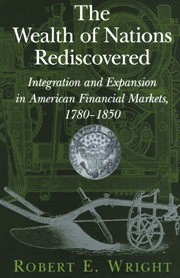 The Wealth of Nations Rediscovered
The Wealth of Nations Rediscovered Book contents
- Frontmatter
- Contents
- List of Tables
- Acknowledgments
- List of Abbreviations
- The Wealth of Nations Rediscovered
- 1 Introduction: The Wealth of Nations and National Wealth
- 2 The International and Colonial Background of America's Financial Revolution
- 3 Banks, Securities Markets, and the Reduction of Asymmetric Information
- 4 The Financial Sector and the Reduction of Lending-Related Costs and Risks
- 5 Evidence of Capital Market Integration, 1800–1850
- 6 Expansion of the Securities Services Sector, 1790–1850
- 7 The Freest of the Free: Regulation of the Financial Sector
- 8 Finance-Directed Economic Development
- 9 Conclusion
- References
- Index
7 - The Freest of the Free: Regulation of the Financial Sector
Published online by Cambridge University Press: 16 January 2010
- Frontmatter
- Contents
- List of Tables
- Acknowledgments
- List of Abbreviations
- The Wealth of Nations Rediscovered
- 1 Introduction: The Wealth of Nations and National Wealth
- 2 The International and Colonial Background of America's Financial Revolution
- 3 Banks, Securities Markets, and the Reduction of Asymmetric Information
- 4 The Financial Sector and the Reduction of Lending-Related Costs and Risks
- 5 Evidence of Capital Market Integration, 1800–1850
- 6 Expansion of the Securities Services Sector, 1790–1850
- 7 The Freest of the Free: Regulation of the Financial Sector
- 8 Finance-Directed Economic Development
- 9 Conclusion
- References
- Index
Summary
The early U.S. financial sector was able to integrate and expand quickly in the first few decades of the nation's existence because politicians and judges allowed it to develop largely unfettered. Attempts of state and national governments to regulate securities markets and banks were relatively meager. While securities markets were almost completely unregulated by government and largely self-regulated, regulations fell more heavily on banks, but even here the market was often able to make adjustments that muted the effects of poorly conceived legislation. For instance, the market managed to offset some of the more pernicious characteristics of New York's Safety Fund, a bank liability insurance scheme with highly politicized origins. In addition, bank taxes in many important states were such an important source of revenue that the taxes may have, somewhat paradoxically, induced those states to follow enlightened probanking policies. Massachusetts, for example, led the nation in banking capacity because its reliance on bank tax revenue logically led it to implement liberal banking policies. Undoubtedly because of its English and colonial roots, particularly the fear of a predatory state, the early nineteenth-century United States had one of the freest financial systems in the world, a world considerably freer from financial regulations than today's.
Securities Market Regulations
The new nation inherited many of the legal practices and precedents of the mother country. Securities regulation was little different. That is not to say, however, that early Americans simply produced a carbon copy of England's laws and legal interpretations.
- Type
- Chapter
- Information
- The Wealth of Nations RediscoveredIntegration and Expansion in American Financial Markets, 1780–1850, pp. 167 - 192Publisher: Cambridge University PressPrint publication year: 2002


